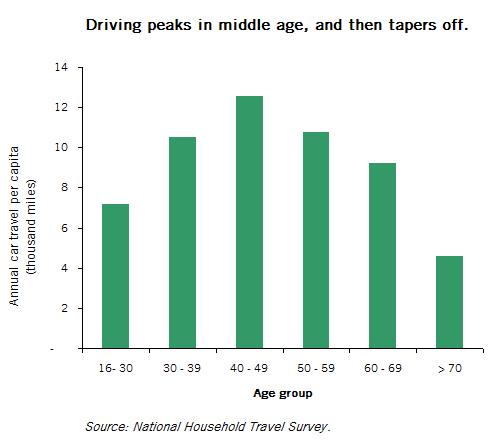Sheesh, kids these days. In a brand new report, the Frontier Group documents the sharp decline in driving among the under-30 set—and argues that those trends won’t reverse themselves any time soon.
I don’t think anybody really knows what the future holds for youth driving. But the Frontier Group has the recent trends nailed down pretty tight. Today’s young folks are less likely to own cars than their older siblings did. Many don’t even bother to get a driver’s license. Those who do drive are logging fewer miles on their cars. Economic shifts make it harder for young folks to afford to drive. Meanwhile, new mobile internet technologies and changing attitudes have reduced the car’s appeal, while boosting transit, biking, and walking. For anyone who wants to understand the changing face of car travel, the report’s definitely worth a read.
But youth are only part of the story of recent driving declines: demographic trends set in motion decades ago are taking a bite out of older Americans’ vehicle travel, too. Sure, folks under 40 have changed their driving habits far faster than us fogies. Yet there’s a monumental demographic shift underway among the older set: more and more baby boomers are entering the stage of life when driving ebbs.
To demonstrate, here’s a chart of annual vehicle miles traveled, broken out by age group. The data comes from the 2009 National Household Travel Survey. In a nutshell: driving peaks between the ages of 40 and 50, when middle-aged folks often have kids and busy careers. But once people hit 50 or so, driving trails off.
For the past few decades, the enormous boomer generation has been moving its way through the peak driving years. But the youngest baby boomer turns 47 this year. And as the boomers continue to age, they’ll drive less, and less, and less.
Right behind them, just hitting their driving prime, sits the smaller “baby bust” demographic—the original gen Xers, born when US fertility rates were at or near their all-time low. Even if, as individuals, the “busters” drive just as much as the boomers did, there are lot fewer of them. In fact, the US census projects that there will be fewer 40-55 year-olds in 2025 than there are today, as the relatively small baby bust generation ages.
So even if you assume that the decline in driving among millenials is just a passing fad, the aging of the boomers and the rise of the busters will still lead to a modest but steady per capita decline in vehicle travel among the over-40 set.
What I draw from all this is that driving trends are being pinched from all sides. Younger people are driving a lot less than they used to—and there’s reason to believe that those trends will persist as they age. Demographic trends, especially the aging of the baby boomers, are paring back driving by older Americans. Meanwhile, rising oil prices have curtailed driving across the board; and the Northwest’s highway departments have begun to flirt with bankruptcy, which could lead to higher gas taxes, more tolling, and/or fewer highway expansions—all of which would further crimp driving.
All in all, it’s a recipe for continued declines in Americans’ appetite for car travel—and possibly the most fundamental shift in society’s attitude towards mobility since the era of the interstate.


Comments are closed.